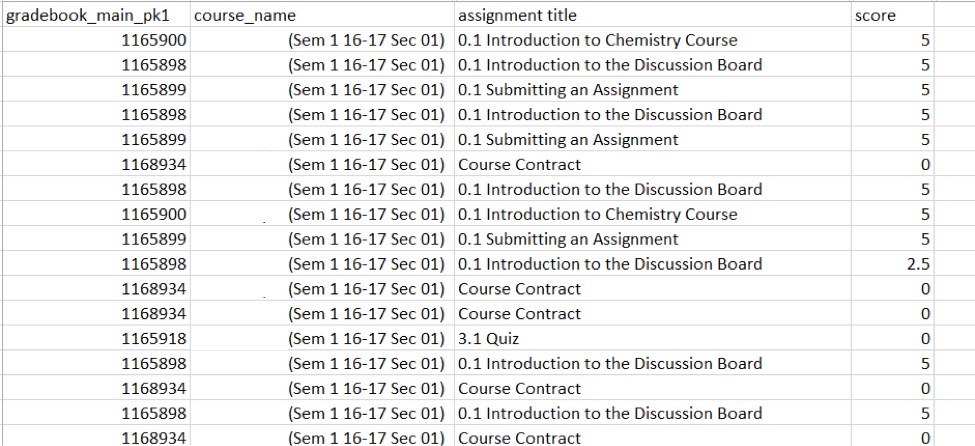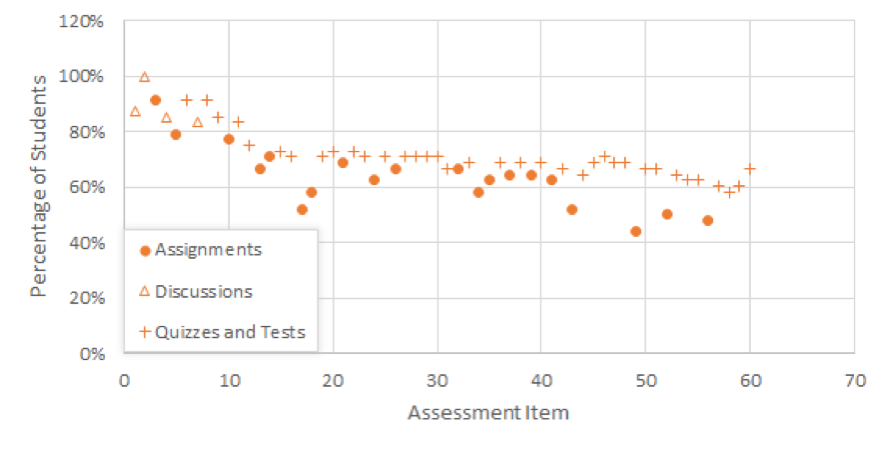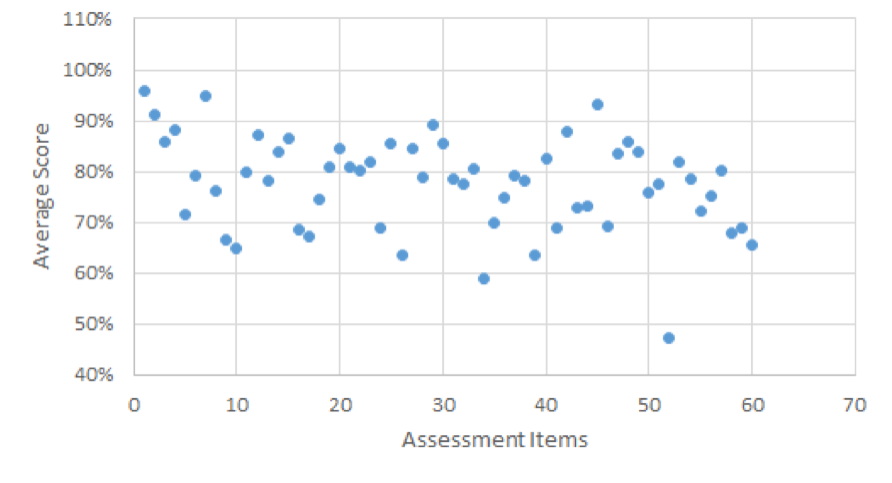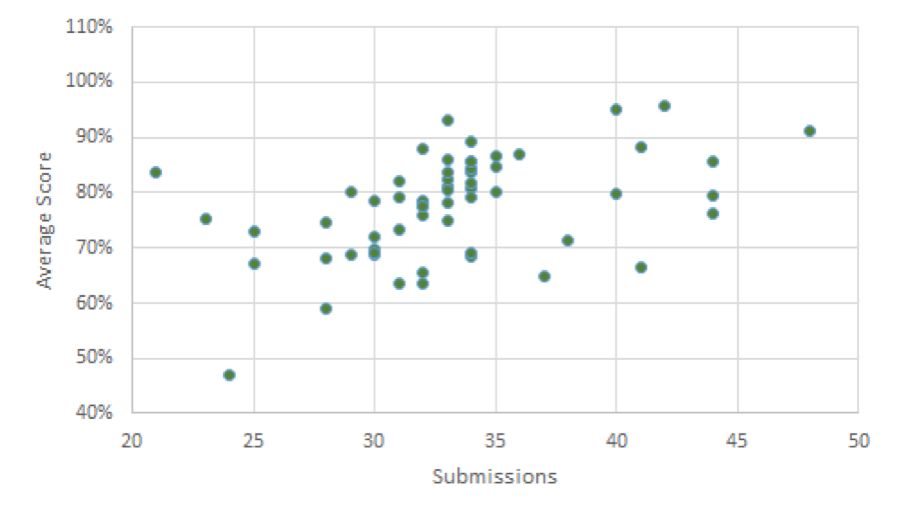
Authors
Andrew Vanden Heuvel, Michigan Virtual
Kristi Peacock, Michigan Virtual
Kristen DeBruler, Michigan Virtual Learning Research Institute
Anecdotal evidence from course designers and Michigan Virtual School® (now known as Michigan Virtual™) instructors suggested that some students were not fully engaged with their online course materials. There was a commonly held belief by instructional staff and designers that some students were picking and choosing which assignments to do and only did the minimum required to get their desired grade. It was thought that some students were spending only as much time in the course as absolutely necessary and, even when they were in the course, not taking full advantage of all course materials. Part one of our two-part blog series on understanding engagement in K-12 online courses explored our use of Google Analytics (GA) and Hotjar and data gathering approaches. Part two will explore the use of learning management system (LMS) data and discuss implications for instructional designers and instructional staff.
LMS Data
Following both the GA and Hotjar data collection, and with the original problem in mind — better understanding student engagement for the reasons stated previously — we next accessed and analyzed readily available data on assignment completion and performance from the LMS data archive.
One way to think about “engagement” is whether students were accessing and spending time with the lesson materials (which is what GA and Hotjar were able to do), but another way to think about “engagement” is whether students were completing their course assignments. One benefit of looking at engagement in terms of assignment completion is the ability to connect engagement and student performance in their online courses.
To start, we identified the most relevant data in the Blackboard (Bb) database. Our goal was to measure the number of students submitting each assignment in a particular class or term. Given that individual courses have multiple sections and instructors but nearly identical course content, we gathered data across all sections and instructors to get a larger sample. We pulled every item in the Bb gradebook from each section of the particular course. For one course, this dataset included over 2,000 gradebook items for the approximately 50 students enrolled in the course. A screenshot of the data set can be seen in Image 1 below.
Image 1. Screenshot of Bb Gradebook Data Set

We then used pivot tables in Microsoft Excel to transform the data set into a more useful aggregate. The data was organized so that each assignment was listed only once in a given row. (See image 6 for a screenshot.) The column “count of assignment title” told us how many times this assignment title appeared in our dataset, which told us how many times a student completed this assignment (i.e., the number of submissions). The column “average of score” told us the average performance on this particular assessment item across all sections of the course. The column “max score” noted the number of points possible for the given assignments.
Image 2. Screenshot of Excel Pivot Table Assignment Count and Score

Once the pivot tables were complete, we calculated the average student performance as a percentage. As was true of earlier work, we found graphs to be more easily understood by those within our team and outside. Thus, we created several graphs charting student engagement.
Figure 1. Count of Assignment Submissions by Assessment Item

This engagement graph not only showed a steady decline in student participation through the course (higher assessment item number indicates placement later in the course), it also demonstrated that students preferentially skipped some assessments, confirming the assumption held by course designers and instructors that served as the catalyst for this research.
Our previous graph demonstrated that students may have been selectively completing assignments. (Consistent completion would have been demonstrated by a horizontal line of dots at the level of the number of students enrolled in the course; several dots are below the relatively stable line of approximately 30 submissions.) We next wanted to know if student performance also varied by assignment. By graphing the average student score by assessment title, we determined how student performance fluctuated and identified assignments where students typically excelled or struggled. This data was invaluable as it clearly identified areas of improvement for our courses and/or instructional methods.
Figure 2. Average Score of Assignment Submissions by Assessment Item

Finally, we were able to combine student engagement and performance to identify assessment items that were outliers in either or both. In Figure 3 below, each dot represents a specific assessment item in the course. By plotting each assignment this way, we were able to identify high engagement/high-performance items (such as the “Introduction to the Discussion Board” assignment, the dot in the far upper right) and low engagement/low-performance items (such as “7.2 What’s in My Name?”).
Figure 3. Average Score by Count of Assignment Submissions

Discussion
Our original work started with the question of how students engage with their online courses and course materials. To answer that question, we used (what were to us) complex methodologies. We were able to partially answer our question through GA and Hotjar and developed a better understanding of “engagement;” but as much as we tried to customize and “fit” GA and Hotjar to our needs, it was never quite right. Our final attempt — the use of readily available LMS data — was by far the most successful and, more importantly, the most useful.
One unanticipated yet positive side effect of our work has been the natural and fruitful collaboration between the instructional design team and instructional staff. This work has created a cyclical, closed-loop system in which designers identify problems within courses, work with instructional staff to develop and implement solutions, and bring those solutions back to the designers to implement in other courses or on a larger scale.
We originally sought a simple solution to a complex problem, one that we could easily collect, compile, and, most importantly, share with instructional staff at all levels. And it was in this final step — the sharing of our work — that we found the most value. Sharing our findings, particularly figures 1, 2 and, 3, led to numerous suggestions of simple interventions, interventions that do not incur prohibitive financial or time costs. Sharing our findings and the resultant discussions led to the idea of tiered interventions. For example, course assignments with the lowest engagement and performance could be flagged by the instructional design team for immediate review. Assignments with low engagement but medium/high performance could be flagged for course instructors who could, in turn, send announcements to students about the upcoming assignment. Should this prove to be an ineffective strategy to increase engagement, the entire instructional team could meet to discuss the possibility of calibrating the point value to incentivize students to complete the assignment. Should graphs like those presented in the figures above prove useful, they can be made easily available to instructional staff on a large scale.
It is worth noting here that the goal of increasing engagement is not to simply increase the amount of time students spend in a course, or to have them complete course activities for the sake of “doing work.” Rather each of our courses are very deliberately designed by instructional designers; and all the activities, assignments, quizzes, discussion boards, and exams are chosen because they have instructional value. The courses are not filled with “busy work,” but rather with activities created to help students learn and understand complex topics. As such, our goal is to have all students engage with the assignments (learn the desired course material) and do well on the assignments (master the course material).
